KITCHEN CUTLERY TYPES AND USES

I heard an interesting story regarding cutlery. In the 1900s, cutlery was durable everywhere, even in prisons. A prisoner made use of one such sturdy spoon, scooped out the concrete on the floor of his jail room, dug a pit of 3 feet, and escaped it. He even left behind the spoon, which remained perfectly good after the ordeal with just a tiny bit of metal missing at the top of the spoon. His escape led to the invention of flimsy flatware, which required just half the metal needed to make their sturdier equivalents. The cheaper version of the tableware is made out of stainless steel, which easily bends and breaks. When the new version of cutlery moved into the market, the poorer sections of society opted for this new variant as it was economical and became an overnight sensation. That’s how cheap cutlery came into usage.
The kitchen cutlery is a set of hand tools used to cook, serve, and mostly eat in Western culture. The cutlery set comprises forks, knives, and spoons. The food is served in a particular order, with appropriate cutlery accompanying each course in a formal lunch or dinner. Proper arrangement of flatware, the language of cutlery, the order and method of usage, and good table manners make the dining experience delightful.
From soup to the first course or appetizer, the main course to the dessert, and finally a hot cup of beverage, the tableware for each one is unique in its size, functionality, and sophistication. Let me walk you through the different types and uses and other fascinating information about kitchen cutlery.
TYPES OF CUTLERY/FLATWARE
Soup Spoon
The word soup delightfully reminds me of the cream of mushroom soup from the restaurant around the corner. It had been my family’s fave for quite some time now.

Soup spoons, also known as ladles, are used for soup or broth serving and designed especially for the purpose. You might be aware that there are two soup spoons, the Western and the Chinese. While the Western soup spoon is round and deep for spooning the soupy liquid, the Chinese variant is oval with a short, thick handle. It thus can easily hold more soup than the Western one.
Soup spoons are placed far away on the right as they are the first used in any course meal. The correct way of having a soup from a bowl or deep soup plate is to spoon it away from you to avoid spilling the soup on your dress. Be mindful of filling only two-thirds of the spoon with the soup to prevent any spillage accidents.
It is traditional to serve crackers or bread along with the soup. Choose your favorite sides to go along with the soup. Kindly avoid dipping the bread in the soup as it is considered rude during formal events. Also, in the States, it is impolite to slurp the soup.
When you are done having the soup, place the soup spoon on the shallow plate. If you had the soup from a cup, leave it on the saucer with its handle facing the right.
Forks
Forks are the assisting equipment for the knife and are on the left side of the plate for that reason. There are different styles of using forks at the table. The two famous ones are American and Continental.
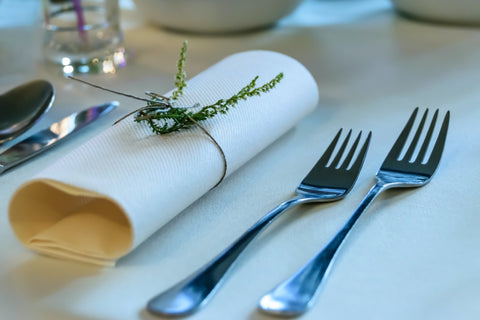
Before coming to America, the British used the forks on the left to hold the food down while the right hand cuts the food. They then shifted the fork to the right to eat with it. They brought this cut-and-switch style to the US, which became the American version of fork handling. Modern British style keeps the fork on the left hand and the knife on the right throughout.
Spoons and forks are the only flatware that goes into the mouth of the diner. Licking or placing the knife in the mouth is considered rude in the formal dinner setting.
Knives
Knives are mainly for the cutting maneuver. They come paired with the forks and are on the right or the dominant hand. These flatware are rounded on the top and flat. The word cutlery comes from an old French word “coutelier,” which means knife. The fork and spoon, later on, were also added under this category.
Forks and knives come in pairs, and while the forks are on the left side of the plate, the knives are on the right with their blades facing inwards.
Fish Fork/Fish Knife – If you happen to stay near the coast, then a fresh supply of fish is an inevitable pleasure that you can often indulge in. You can even have the fish for the main menu, and it gives you a chance to add the fish fork and fish knife to the dining cutlery.
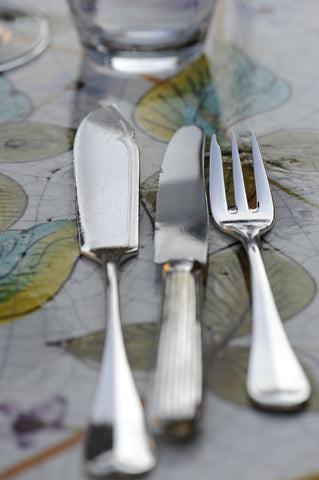
Fish Fork – A fish fork is a fork that is a bit bigger than the salad fork and has three to four tines in it. It is incurved on the sides to distinguish it from the other forks.
They help to clean and eat the fish with ease. They come along with a fish knife placed on the plate’s right side, along with the other knives.
Fish Knife – This knife beautifully pairs up with the fish fork in its looks with a similar notch on its sides and a pointed head. You can easily make out the pair among the other cutlery.
A fish knife is used to slit the skin of the fish and break the fish. Therefore, holding the fish knife is different from holding the other knives because it breaks the fish and does not cut it.
Usually, we place the fish fork on the left of the dinner fork and the fish knife on the right of the dinner knife when it is an appetizer. However, if fish is the main course, the fish fork and the fish knife are placed instead of the dinner fork and the dinner knife.
Dinner Fork/Dinner Knife –After enjoying the starters and the appetizers, you are now into the main course, and now is the time for real dining.
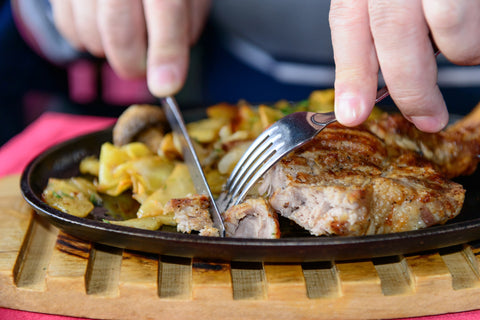
Dinner Fork – You will be using a dinner fork to eat the main course of the meal. You can easily make it out as it is the biggest of all forks.
Dinner Knife – The dinner knife is the longest of all knives kept on the table. It is of moderate sharpness with slight serration that easily cuts through cooked meat and poultry served as the main course, with a pointed end.
Salad Fork/Salad Knife
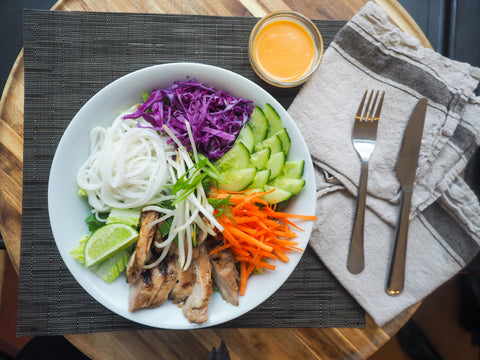
Salad Fork – Go ahead and reverse dinner fork and salad fork according to the servings. The salad fork’s tines are broader and flatter. It is slightly different from the dinner fork because it involves piercing salad greens and requires some effort.
Salad Knife – Your salad knife will have a serrated edge to cut the greens and is smaller than a dinner knife. You can swap it with the dinner knife if the servings are the other way round.
Dessert Fork/Dessert Spoon
Who can say no to the dessert! A full-course meal is never complete without a dessert.
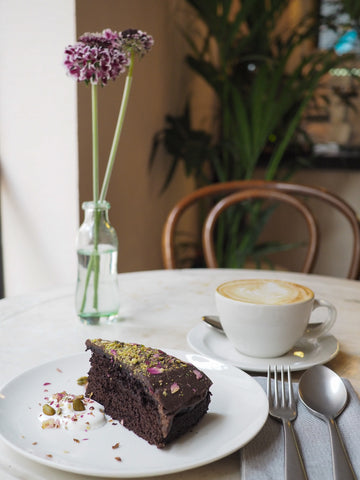
Dessert Fork – I’m always in the mood for a dessert. No wonder this fork has so many names – pastry fork, pie fork, cake fork, etc. To easily scoop the sweet dish, these three or four-pronged forks are bridged at the base of the prongs.
It is very similar in appearance to the salad fork, only a bit narrower than that.
Dessert Spoon – The dessert spoon will suffice for the softer dessert, while the dessert fork is essential for eating fruit toppings.
You have to arrange the dessert spoon and the dessert fork on the dessert plate with the spoon pointing to the left and the fork pointing to the right adjacent to each other.
Butter Knife
I use the master knife for helping out in individual servings of butter from the butter dish kept at the center of the table. This butter spreader is saber shaped, dull edged with a semi-pointed tip.

It is easy to find the butter knife as it is placed on the bread plate with its tip pointing to the left and cutting edge facing down. This position makes it easy for the guest to reach its handle. Your forefinger should go on top of the butter knife while the other fingers hold on to the side for using the butter knife.
If you find the butter knife missing, you can use the dinner knife instead.
Oyster Fork
Are you serving seafood for dinner?
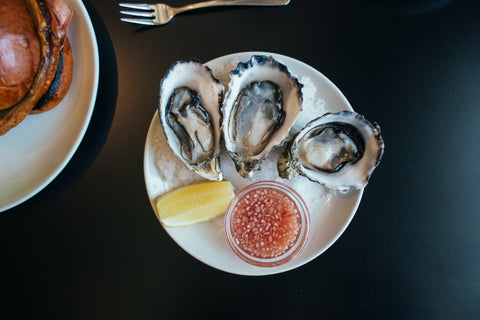
The oyster fork is the odd man in the crowd and the only fork placed on the plate’s right side. So be ready to shuck the oysters if you find a fork on the right side of the plate. This three-pronged fork comes in handy for deshelling an oyster or grasping the shrimp from your prawn cocktail.
Steak Knife and Steak Fork
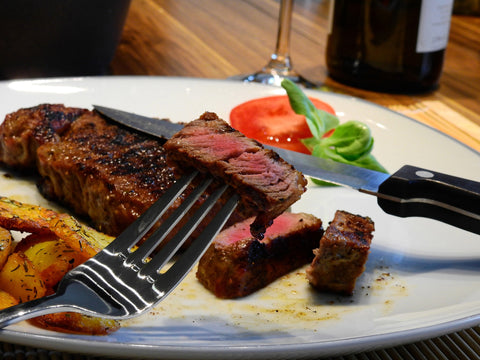
Steak Knife – Be careful with this one as this is the only sharp knife found in the table setting. It goes by its name and is used to cut steak and other cooked meats. It has a serrated edge and a wooden handle for a better handgrip.
Water Glass, Red Wine Glass, And White Wine Glass
Nothing can replace water. It is essential to place a water glass on the right side of the plate above the dinner knife. You can set the wine glasses on the right of the water glass in the order of their servings.
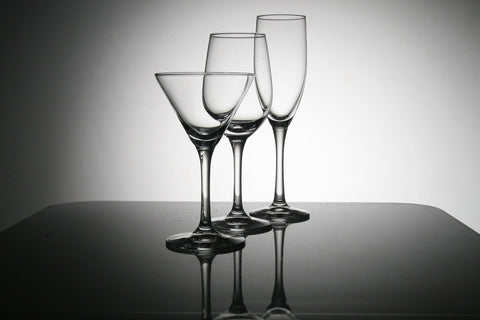
Teaspoons for Coffee and Tea
The coffee spoon is smaller than the teaspoon. However, both have the similar function of stirring and mixing the hot beverage of choice after dinner.

LANGUAGE OF CUTLERY:
The table setting is a piece of art by itself. The host lovingly decorates the table giving attention to small details like laying down the napkins, placing the precious pieces of cutlery, and finally, serving the carefully and meticulously prepared servings. The guest honors the invitation, presents himself suitably dressed for the occasion, sets his time aside, comes for dinner, and leaves a reply on the table by leaving the cutlery at a particular position.
1) Pause/Break – If you are taking a break, the cutlery is kept at right angles to each other with their handles on the plate and not touching the table (or at an inverted V). This position means that the guest will continue eating and has just taken a break.
2) Next Plate – The fork and the knife cross each other at the middle forming a cross symbol, with the fork pointing up and the knife blade facing the left. This means that you are ready for the next dish.
3) Excellent – To convey that the feast was outstanding, the guest will place the cutlery parallel to each other on the plate with their handles pointing to the left.
4) Not to my liking – This one is going to be rare, but if the guest didn’t like the food, he will arrange the silverware in an inverted V and insert the knife into the teeth of the fork.
5) Finished – To say that you have finished eating and that the plate can be removed, place the cutlery straight up parallel to each other.
Fusion cutlery has evolved as part of modernization in the cutlery industry, such as spork (spoon and fork), spife (spoon and knife), knork (knife and fork), and sporf (a mixture of all three, spoon, knife, and fork).
As we close, let us quickly look into the different changes that the tableware took from metal to edible ones. First, the silverware was made in silver. And just as if it were a performer, it never stopped changing its attire. Much to the delight of many, the silverware then switched to stainless steel, which was dishwasher-friendly. But, unfortunately, plastic cutlery came up in recent times and trashed the face of the earth, polluting the land, water, and air.
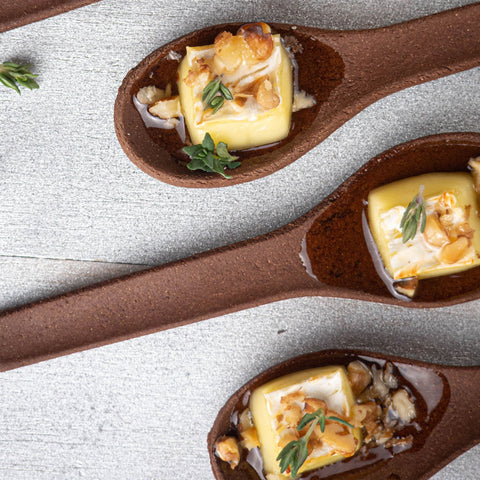
Bamboo ones and coconut shell cutlery brought much hope with them as both are natural products. However, millet-based, edible cutlery stands out the best in the cutlery-making industry’s transformations. This flavorful edible cutlery is consumable, nutritious, tasty, biodegradable, eco-friendly, and a groundwater saver. With such innovations, the future of cutlery remains bright and promising.
Bon appetit!

